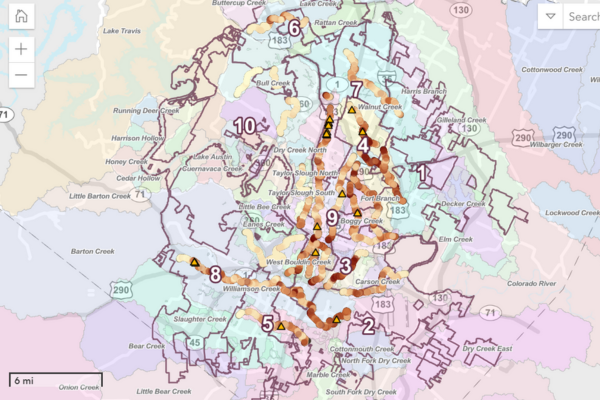Where did we study trash in creeks?
Our scientists surveyed 110 miles along 20 Austin creeks in 2022. Observations were collected every 30 feet in these creeks for a total of 19,467 distinct locations. At each location, we recorded information on the amount and sources of trash.
View an interactive map that shows where the trash is.

Where does trash in creeks come from?
We looked at seven trash sources and documented their locations and the amount of trash associated with them. Surprisingly, the amount of trash in the creek did not correlate well with any of the nearby sources. This implies that all of these sources as well as the whole community are part of the problem rather than any single source being largely responsible.
- Dumping with a known point source such as items dumped by an identifiable residence, commercial entity, or other responsible party
- Historic dump sites that have been exposed due to erosion or storm events
- Dumping from an unknown source
- Overflowing dumpster
- Encampment
- Outfall/Tributary where a storm drain system releases water into the creek or a smaller stream flows into a larger one
- Property management, which includes activities that property managers or their contractors do or don’t do with respect to trash on their property
What did we learn about trash in creeks?
- Single-use plastics were the most common items observed.
- Trash tends to accumulate in certain locations. 76% of all the trash was observed in only 10% of the study area. Knowing the locations where trash concentrates may improve the efficiency of future cleanup efforts.
- The locations where trash accumulates are based on the characteristics of the creek rather than nearby human activity.
- The sources of trash in our waterways is complex and is a result of the entire community. There is no one source primarily to blame.
- Only 21 scooters were discovered in creeks for an average of 1 scooter every 5 miles. This is despite the thousands in use around town. Austin now has a process to quickly get scooters out of creeks. If you see a scooter in a waterway, please contact Austin 3-1-1 or use the Austin 3-1-1 mobile app to report the location and brand so we can have them removed immediately.
What are strategies to help?
There are three approaches. We can remove trash once it's already in the creek, prevent it from reaching the creek once it's been discarded or we can reduce the amount of trash in the first place.
- Extraction: Strategies to remove trash from creeks
-
New technologies like robotic trash-collecting devices and passive strategies like trash booms don’t work well for Austin. This is because of our intense storms and large amounts of organic material, such as wood and leaves, that clog devices. Removal by hand is still the most effective method. We should focus on improving the efficiency of these physical efforts:
Focus creek cleanups strategically at locations with the most trash. Coordinate the efforts of City staff and organized volunteer efforts to maximize effect. Promote and facilitate groups that collect trash in parks, on kayaks, etc.
- Interception and Enforcement: Strategies to keep trash out of creeks
-
Once the trash is on the landscape, a storm or wind could bring it to the creek. We must find ways to stop trash traveling from the land to our waterways:
Regulations to reduce the effects of overflowing dumpsters. Encourage containment barriers around dumpsters to retain overflowing items. Rules that require telecommunication service providers to remove their abandoned cables when the service provider changes. Evaluate existing street sweeping programs and identify ways to improve effectiveness Help businesses identify strategies to keep their shopping carts within their property boundaries. Adopt a Storm Drain is a new program that catches trash before it goes into a storm drain.
- Source Reduction: Strategies to reduce litter in the city
-
Our community’s dependence on disposables is the main reason there is so much trash in our waterways. Source reduction can be achieved through education, legislation, and individual responsibility:
Campaigns or strategies to reduce the use of single-use plastics Educate the community about the complex path litter takes to reach our creeks and habits the public can incorporate in their daily lives Collaborate with other departments for a citywide, integrated trash management effort Individual responsibility to stop depending on single use plastics, like bringing your own tupperware containers for leftovers when you go to a restaurant.
What Can You Do?
Documents and Resources
Acknowledgements
Thank you to contractors, volunteers, and our partners:
Questions?
Becca Villarreal, Public Information Specialist, 737-291-3093, becca.villarreal@austintexas.gov

